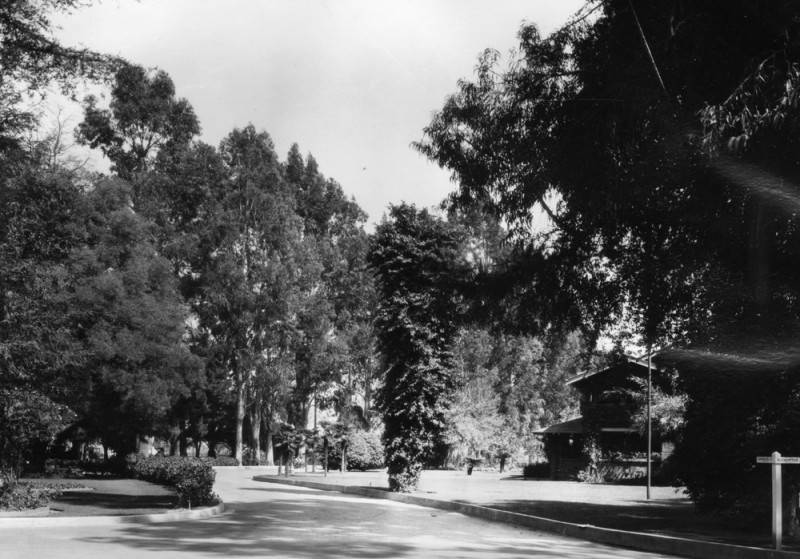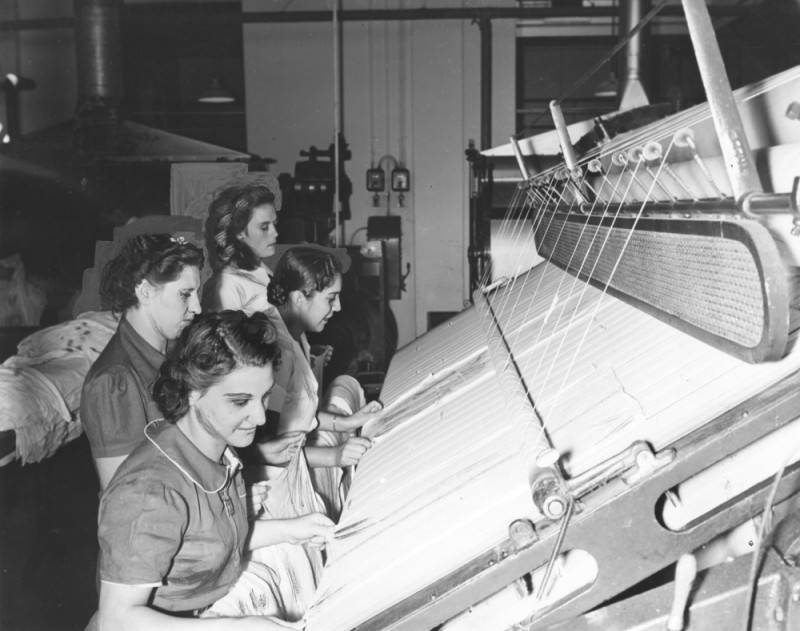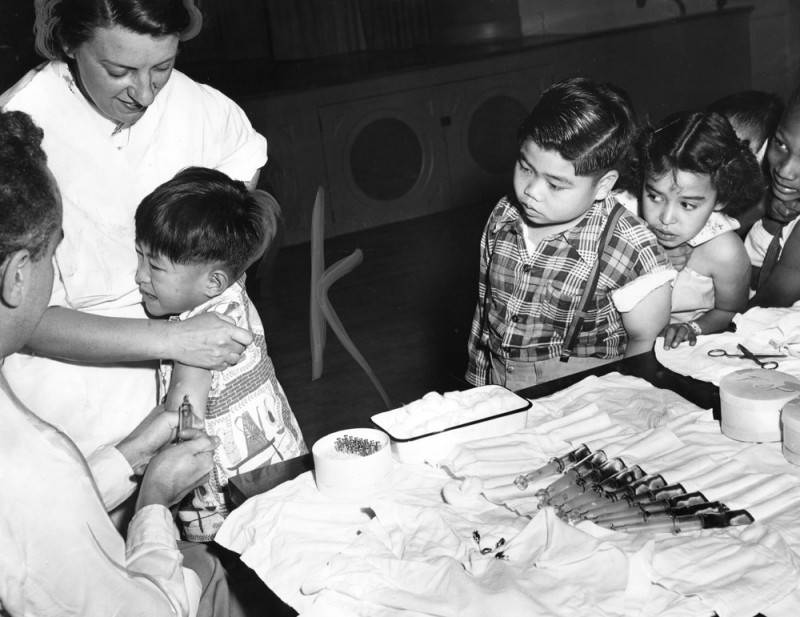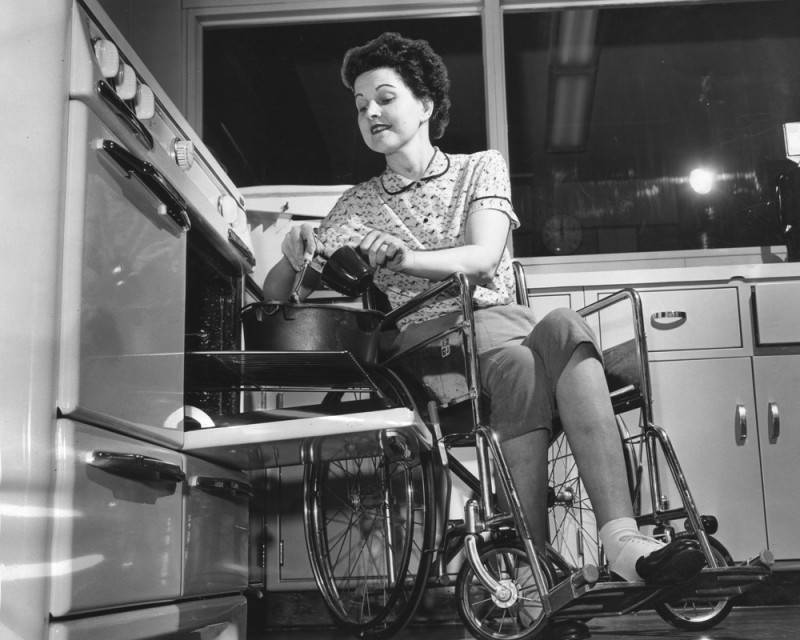The County Farm in 1928: the institution for the indigent, aged, and disabled was designed as a bucolic setting with winding roadways and shade trees. The superintendent’s house is seen at left. (On a side note, the house was used as the principal setting in the comedy horror film Bubba Ho-Tep in 2002.) Security Pacific National Bank Collection, Image #00072843.
Since the dawn of time, we have struggled with the question of how best to help the unfortunate: the poor, homeless, sick, disabled, and elderly. One institution that has paralleled changing approaches to human services is Rancho Los Amigos, a sprawling complex in the city of Downey. Photos from the library’s collection document the life of this enduring public charity.
Beginnings – the Farm
Rancho Los Amigos had its origin as the Los Angeles County Poor Farm, a term that has fallen out of favor. In 1887 the county purchased open land near the town of Downey and built a large facility to handle an overflow of indigent and disabled persons from the county hospital. The first residents arrived a year later.
The poor farm concept was nothing new. It had its origin in the centuries-old Elizabethan poor laws and the idea that indigent people should work for their living unless they were completely disabled by age or infirmity. At the Farm able-bodied residents were assigned to work the fields, the orange orchard, or the dairy, producing food for the facility as well as for sale. By 1923 the charity had 400 acres of farmland and 150 milk cows producing 500 gallons of milk a day.
A “milk maid” prepares to milk a cow at the County Farm, circa 1923. Security Pacific National Bank Collection, Image #00072851.
Transitioning to a Medical Facility
In the decades that followed, the farm gradually pivoted toward serving more residents with chronic illnesses and severe disabilities, including mental illness. Ultimately the farm operation was abandoned and the institution became exclusively medical in nature. Name changes reflected the shifting focus: in 1918 the term “poor farm” was dropped in favor of the simple name Hondo, after the community and river in the vicinity. In 1932, the name changed again — to Rancho Los Amigos, “Ranch of the Friends.” More archaic terms, such as almshouse, insane asylum, and sanitarium, are fortunately largely forgotten.
The Rancho grew over the years, building new facilities on the abandoned farmland and expanding to the north where more modern buildings were sited. The institution earned a solid reputation for innovations in physical therapy, occupational therapy, and the use of medical devices, such as the iron lung and the halo vest. In 1982, the it became Rancho Los Amigos Medical Center; two decades later the hospital was given one more name: Rancho Los Amigos National Rehabilitation Center, with modern facilities concentrated on the north campus. About the same time, the south campus was abandoned to become a curiosity for urban explorers and ghost hunters.
The property’s Spanish Colonial style administration building was completed in 1923. Security Pacific National Bank Collection, Image #00072850.
Job-training was a big part of the Rancho experience. In addition to farm and dairy work, residents could learn to operate laundry equipment, build furniture, or work a printing press. Others benefited from the facilities available at the Rancho. These young women, part of the New Deal’s National Youth Administration, press sheets in a large mangle in 1939. These women were employees, not residents. Herald Examiner Collection, Image #00047239.
Public Health Crisis: the Polio Epidemic
Today we can hardly comprehend the fear that accompanied the polio epidemics that bedeviled the United States, and other countries, in the 20th century. It can compare only to other little-understood contagions such as AIDS in the 1980s and COVID-19 today. Poliomyelitis is a crippling, virus-driven disease with a history going back to ancient Egypt. Increasing urbanization, with crowded and unsanitary conditions in the late 19th and early 20th century led to widespread outbreaks. Unlike AIDS and COVID, polio hit young children particularly hard. While many of those infected suffered only minor symptoms, a significant number developed severe illnesses that included muscle weakness, breathing difficulties, and paralysis. Many died until the development of polio vaccines in the 1950s and 60s.
Schoolchildren with left arms bared prepare for inoculation against polio, San Pedro School, May 16, 1955. Herald Examiner Collection, Image #00055422.
The vaccine came too late to prevent the worst outbreak in U.S. history, in 1952. Los Angeles saw serious outbreaks of polio throughout the 1940s and 50s. The Rancho opened a polio ward in 1944 with 32 patients, the start of what would become a premier polio treatment center offering the latest therapies.
The polio ward at Rancho Los Amigos, 1949. Herald Examiner Collection, Image #00056927.
Newspapers and the public were fascinated with the strange contraption called the iron lung adapted for the use of patients with respiratory failure due to polio. Photos of people confined to these tube ventilators, many for months or years, abounded. Here a Rancho boy confined to the machine is instructed in knot-tying by his Boy Scout buddies. A mirror placed at an angle allowed the patient to view something other than the ceiling. Valley Times Collection, Image #00123046, February 1, 1964.
This likely staged image from 1955 shows polio patients on a covered patio at the Rancho. A rocking bed, allowing for the patient to be repositioned such that gravity will assist respiration, is seen next to an iron lung. The nurse has access to a portable telephone allowing her patient contact with friends and family. Herald Examiner Collection, Image #00047238, 1955.
A new polio center at the Rancho was dedicated in February, 1955, to meet the needs of growing numbers of disabled polio survivors. For the event, Mrs. Maezella Houdyshell demonstrated the model kitchen at the facility. Herald Examiner Collection, Image #00047241.
Rancho Los Amigos may have been tucked away, but it was not forgotten. Many community charities and service organizations lent a hand. Here clowns entertain Rancho children at a Yule party in 1963. Herald Examiner Collection, Image #00047236.
Today the modern Rancho Los Amigos National Rehabilitation Center is a respected rehabilitation hospital serving approximately 2,500 people annually on an inpatient basis and many thousands more with outpatient services. Meanwhile, the old buildings of the original Rancho lie neglected behind chain link fencing, some of them already demolished. A number of plans have been proposed for these derelicts, everything from repurposing them for the homeless again to complete demolition. A proposal to replace the campus with county buildings was approved by the Los Angeles County Board of Supervisors in June 2020, despite appeals from preservationists. While the complex is closed to the public, many photos of the decaying structures are available via a quick internet search.










